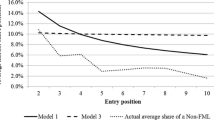Abstract
This paper considers the diffusion process of new brands in order to estimate marketing mix elasticities and order-of-entry effects. Using an empirical case, we test hypotheses regarding the role of order of entry on brand trial processes within a new category. Consistent with research hypotheses, the results demonstrate that the diffusion rate of a brand's trials and its pricing and advertising elasticities vary systematically as a function of competitive entry. Competitive influences (which are negative) increase as order of entry is delayed. Short-term price elasticities are found to be an inverted U relationship with the order of entry, whereby early followers have the highest elasticities, as compared to the pioneer and to later followers. Advertising elasticities decline as the number of competitors increases.
Similar content being viewed by others
References
Arora, Rahindas. (1979). “How Promotion Elasticities Change.”Journal of Advertising Research 19 (June), 57–62.
Bass, Frank M. (1980). “The Relationship Between Diffusion Rates, Experience Curves, and Demand Elasticities for Consumer Durable Technological Innovations.”Journal of Business 53(3) (July), Part 2, 51–67.
Bond, Ronald S., and David F. Lean, (1977).Sales Promotion and Product Differentiation in Two Prescription Drug Markets. Washington, DC: Federal Trade Commission.
Carpenter, Gregory S., and Kent Nakamoto. (1989). “Consumer Preference Formation and Pioneering Advantage.”Journal of Marketing Research 26 (August), 285–298.
Carpenter, Gregory S., and Kent Nakamoto. (1990). “Competitive Strategies for Late Entry into a Market with a Dominant Brand.”Management Science 36(10) (October), 1268–1278
Feick, Lawrence F., Linda Price, and Robin People Higie. (1986). “Who Use People: The Other Side of Opinion Leadership.”Advances in Consumer Research 13, 301–305.
Fershtman, Chaim, Vijay Mahajan, and Eitan Muller. (1990). “Market Share Pioneering Advantage: A Theoretical Approach.”Management Science 36(8) (August), 900–918.
Fourt, Louis A., and Joseph W. Woodlock (1960). “Early Prediction of Market Success for New Grocery Products.”Journal of Marketing 25 (October), 31–38.
Gatignon, Hubert, Erin Anderson, and Kristiaan Helsen. (1989). “Competitive Reactions to Market Entry: Explaining Interfirm Differences.”Journal of Marketing Research 26 (February), 44–55.
Gatignon, Hubert and Thomas S. Robertson. (1985). “A Propositional Inventory for New Diffusion Research.” Journal of Consumer Research 11 (March), 849–867.
Gatignon, Hubert, Barton Weitz, and Pradeep Bansal. (1990). “Brand Introduction Strategies and Competitive Environments.”Journal of Marketing Research 27 (November), 390–401.
Golder, Peter, and Gerard Tellis. (1993). “Pioneer Advantage: Marketing Logic or Marketing Legend?”Journal of Marketing Research, 158–170.
Kalyanaram, Gurumarthy, and Gen L. Urban. (1992). “Dynamics Effects of the Order of Entry on Market Share, Trial Penetration, and Repeat Purchases for Frequently Purchased Consumer Goods.”Marketing Science (Summer), 235–250.
Lieberman, Marvin B., and David B. Montgomery. (1988). “First-Mover Advantages.”Strategic Management Journal vol. 9, 41–58.
Liu, L., and Dominque Hanssens. (1981). “A Bayesian Approach to Time-Varying Cross Sectional Regression Models.”Journal of Econometrics 15, 341–356.
Mahajan, Vijay, Eitan Muller, and Frank M. Bass. (1990) “New Product Diffusion Models in Marketing: A Review and Directories for Research.”Journal of Marketing 54(1), 1–26.
Moore, Michael J., William Boulding, and Ronald C. Goostein. (1991). “Pioneering and Market Share: Is Entry Time Endogenous and Does It Matter?”Journal of Marketing Research 28 (February), 97–104.
Parker, Philip M. (1988). “The Effects of Competition on the Diffusion of Innovations.” Ph.D. Dissertation, The Wharton School, University of Pennsylvania.
Parker, Philip M. (1992a). “Price Elasticity Dynamics Over the Adoption and Life Cycle.”Journal of Marketing Research 29 (August), 358–367.
Parker, Philip M. (1992b). “Pricing Strategies in Markets with Dynamic Elasticities.’Marketing Letters 3(3), 227–237.
Parker, Philip M. (1994). “Aggregate Diffusion Forecasting Models in Marketing: A Critical Review.”International Journal of Forecasting 10, 353–380.
Parker, Philip M., and Gatignon, Hubert. (1994) “Specifying Competitive Effects in Diffusion Models: An Empirical Analysis.”International Journal of Research in Marketing 11, 17–39.
Parsons, Leonard J. (1975), “The Product Life Cycle and Time Varying Advertising Elasticities.”Journal of Marketing Research 12(3) (November), 476–480.
Peterson, Robert A., and Vijay Mahajan. (1978). “Multi-Product Growth Models.” In Jagdish Sheth (ed.),Research in Marketing (vol. 1) (pp. 201–231). Greenwich, CT: JAI Press.
Pringle, Lewis G., R. Dale Wilson, and Edward I. Brody. (1982). “NEWS: A Decision-Oriented Model for New Product Analysis and Forecasting.”Marketing Science 1 (Winter), 1–29.
Robinson, William T. (1988). “Marketing Mix Reactions to Entry.”Marketing Science 7(4) (Fall), 368.
Robinson, William, and Claes Fornell. (1985). “Sources of Market Pioneer Advantages in Consumer Goods Industries.”Journal of Marketing Research 22 (August) 305–317.
Rogers, Everett M. (1983).Diffusion of Innovations. New York: Free Press.
Schnaars, S.P. (1994).Managing Imitation Strategies: How Later Entrants Seize Markets from Pioneers. New York: Free Press.
Tellis, Gerard J. (1988). “The Price Elasticity of Selective Demand: A Meta-Analysis of Econometric Models of Sale.”Journal of Marketing Research 25 (November), 331–341.
Urban, Glen L., Theresa Carter, Steven Gaskin, and Zofia Mucha. (1986). “Market Share Rewards to Pioneering Brands: An Empirical Analysis and Strategic Implications.”Management Science 32(6) (June), 645–659.
Author information
Authors and Affiliations
Rights and permissions
About this article
Cite this article
Parker, P.M., Gatignon, H. Order of entry, trial diffusion, and elasticity dynamics: An empirical case. Market Lett 7, 95–109 (1996). https://doi.org/10.1007/BF00557314
Issue Date:
DOI: https://doi.org/10.1007/BF00557314




